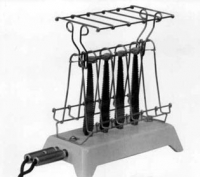GE's First Toaster
General Electric's GE First Toaster was a two-slice model with a porcelain base and a warming tray on top, the D-12. Such products were made possible by the perfection in 1907 of long-life nickel-chrome alloy electrical resistors.
The exposed heating coils were a hazard, but they were tested and approved in 1909 by Underwriters Laboratories (founded 1894) along with a Westinghouse model. The D-12, built on assembly tables by women, was widely distributed and would remain in production until 1913.
Such appliances were traditionally placed on a special wooden "cooking table" which had electrical outlets for individual appliances such as water kettles, cookers and pop-corn poppers, and a separate oven. GE produced its first one in 1905. A true "electric cook stove" was not on the market until 1910 (See Hughes Range).
General Electric was formed in 1892 with the consolidation of the Edison General Electric Company and the Thomson-Houston Company. It entered the "housewares" business with an electric desk fan in 1889. In 1900 it established a research laboratory under consultant Charles Proteus Steinmetz (1865-1923), the first of its kind. GE produced its first electric iron in 1904. By 1908 the research lab had a staff of 8. In 1910, the US standardized on alternating current at 60 cycles and 120 volts. By 1917, the GE research lab had a staff of 298, and by 1918, there would be some 375 similar industrial research labs in the US.
